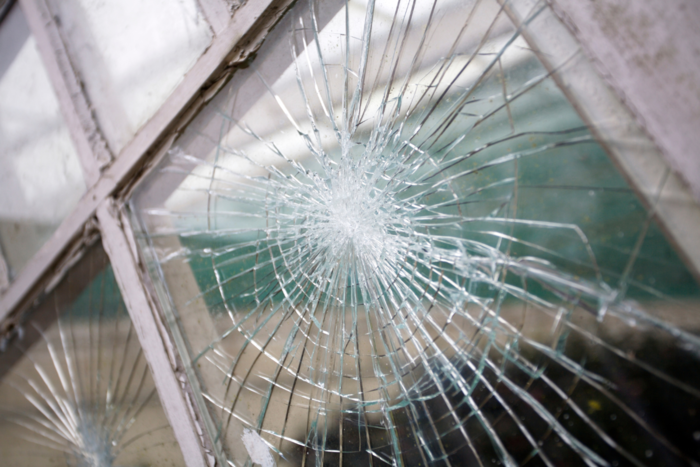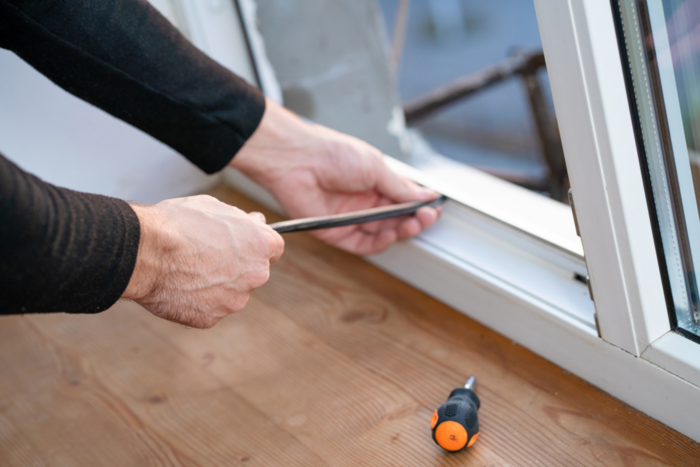You hear a crack—or worse, a sudden shatter. Whether it’s a stray football, a harsh winter storm, or a worn-out hinge finally giving in, a broken window is more than just an inconvenience. It can compromise your home’s insulation, comfort, and security. So what should you do when a window gets damaged or stops working properly? In this Fenbro guide, we walk homeowners through the most common causes of window damage, typical repair and replacement costs, who’s responsible in rental situations, and how to prevent issues in the first place.Whether it’s a quick fix or a full replacement, here’s everything you need to know.
Why do windows break? — main causes
Windows are exposed to various stresses daily. The most common causes of damage include:
Mechanical impact
Objects like balls striking the window, accidental impacts during furniture movement, renovation mishaps, or attempted break-ins can lead to glass breakage. Even slamming a window shut can damage the fittings or frame.
Material wear and tear
Over time, especially in older wooden or uPVC windows, signs of wear appear—such as cracks in the frame, warped sashes, or brittle seals. These issues may require you to fix broken window pane glass or replace a window seal entirely.
Moisture and mould
Defective seals or thermal bridges allow moisture ingress, leading to condensation, mildew, or mould—particularly during colder months.
Thermal stress
Sudden temperature changes—like direct sunlight or proximity to heaters—can cause stress cracks in the glass. A double pane window cracked on the inside is especially vulnerable.
Window repair or replacement?
Not every type of damage means you need to replace the entire window. Buying a new window straight away isn’t always necessary. So, when is which solution appropriate?
Glass breakage
If you have single glazing, replacing the individual broken window pane is often enough. For double or triple glazing, however, the whole insulated glass unit usually needs replacing. This is a task best left to professionals.Not sure which type of glazing is best for your home? Read our guide on double vs triple glazing to help you decide.
Defective seals
Perished, brittle, or torn seals can be swapped out quickly and at relatively low cost. This can restore thermal efficiency and prevent future damp or mould issues.
Fittings and mechanisms
When a window jams or won’t shut properly, it’s often due to worn-out hinges, handles, or striker plates. Replacing these fittings is typically simple and cost-effective.
Frame repair
Minor issues in wooden frames—such as cracks or soft spots—can typically be filled or repaired. uPVC frames are more difficult to mend; in such cases, full frame replacement may be necessary.
How much does a window repair cost?
Window repair costs in the UK and Ireland can vary significantly depending on the type of damage, window size, glazing, and location. Below is a general price guide in euros:
| Repair Type | Approximate Cost (€) |
| Single glazing pane replacement | from €100–150 |
| Double or triple glazing unit | from €200–400 |
| New seals | approx. €10–50 |
| Replacement parts (handles, hinges) | from €10–30 per item |
| Full window replacement | from €400–1,000+ |
Please note: Installation fees may apply. Tip: Always request multiple quotes to compare prices and services.If you’re considering a full window replacement, have a look at our range of Fenbro windows.
Broken window in a rental: who’s responsible?
In both the UK and Ireland, landlords are generally responsible for maintaining the structure and exterior of the property, which includes windows and doors.
United Kingdom:
- Landlords must ensure the property is safe and habitable, covering repairs to the structure, exterior, and installations for water, gas, electricity, sanitation, heating, and hot water.
- Tenants are expected to take care of the property, perform minor maintenance, and report any damages promptly.
Ireland:
- Landlords are responsible for structural repairs and maintaining fixtures and fittings provided with the tenancy.
- Tenants should maintain the interior in reasonable decorative order and handle minor repairs.
If the tenant causes damage (e.g., through misuse or negligence), they may be liable for repair costs. Promptly reporting any defects is crucial to prevent further deterioration.
Insurance cover — who pays in case of damage?
The type of insurance that covers damage depends on how the damage occurred:
- Liability Insurance – may cover the cost if someone (e.g., a visitor) accidentally breaks your window. This is often part of home or contents insurance.
- Contents Insurance – typically covers damage or loss due to break-ins, including internal damage. However, it usually doesn’t cover the window itself unless accidental damage cover is included.
- Buildings Insurance – covers structural damage to the property, such as broken windows caused by storms, vandalism, or burglary. This type of insurance is frequently held by the landlord or homeowner.
Not all types of damage are automatically covered. Always check the details of your insurance policy to understand what’s included and whether optional extras like accidental damage protection are in place.
How to keep windows in great condition? Prevention and care
Regular maintenance can prevent many issues. Here are some simple tips:
- Check and replace seals annually if needed to avoid needing to replace broken window pane components
- Lubricate hinges and fittings to ensure smooth operation and prevent a stuck window
- Use burst ventilation instead of leaving windows open constantly
- Don’t slam windows—gentle opening and closing protects the mechanism
Common mistakes in window installation – causes of defects and damage
A high-quality window doesn’t guarantee performance on its own. Poor or rushed installation can lead to major long-term issues. Even small errors during fitting may result in damage or unnecessary costs.
Misaligned installation
Problem: The window isn’t installed level or plumb.
Consequences: The window becomes difficult to open or close, places strain on the hinges and handles, and may cause seals to shift or fail.
Poor sealing
Inside (airtight): Warm indoor air seeps into the connection joints, creating condensation, mould, and structural damage.
Outside (rainproof): Rainwater can penetrate and cause damp patches, heat loss, and faster deterioration of materials.
Incorrect or insufficient fixing
Problem: The window hasn’t been properly anchored in the wall or incorrect fasteners have been used.
Consequences: The window can shift over time, particularly under wind pressure or vibrations, leading to damage, leaks, or warping.
Poor frame-to-wall connections
Problem: The joint between the window frame and the wall is poorly insulated or filled with inappropriate material.
Consequences: Thermal bridging can occur, causing heat loss, condensation, and higher heating bills. It also reduces sound insulation.
Improper installation of glazing units
Problem: Even minimal tension in the frame of a multi-glazed window can lead to stress.
Consequences: The glass may crack or break—especially during temperature fluctuations or impact. In many cases, full replacement is required.
Summary: what can go wrong with poor installation?
Incorrect installation isn’t just a minor issue—it can permanently damage even the best-quality window. Components frequently affected include:
- Mechanisms and fittings: sticking, jamming, premature failure
- Glazing: cracks and glass breakage
- Seals: loss of airtightness or water resistance
- Frames: warping or shifting
- Junctions and joints: damp patches, mould, or cracked plaster
Buying windows online — delivery & transport risks
It’s not just the installation that can be problematic—window transport itself carries significant risk. Damage can occur before your window even reaches your home, especially with large glazing units or custom-made elements. Common causes include vibrations during transit, improper stacking, or poor securing in the delivery vehicle.Typical transport damage includes:
- Cracks or complete breakage of the glazing
- Chips or dents in the frame or corners
- Warping caused by improper storage
Who is liable for transport damage?If the window was purchased online or through a professional supplier, the seller is usually responsible for ensuring safe delivery. Reputable companies ship their products insured, meaning any damage incurred during transit should be covered by the seller or their delivery insurance. Want to know how we do it at Fenbro? Read our guide on how we transport windows from Poland to ensure they arrive safely and damage-free.Important tips to protect your claim:
- Inspect the goods immediately upon delivery – ideally in the presence of the driver.
- Document any damage – take clear photos and mark any issues on the delivery note.
- Report damage straight away – preferably within 24 hours of receipt.
Tip: When buying windows online, choose a supplier who offers insured delivery and, if possible, works with trusted installers or offers an optional fitting service. This provides peace of mind and a clear point of contact in case something goes wrong. At Fenbro, we provide both—so you get peace of mind and a clear point of contact in case something goes wrong.
Window check — spotting defects easily
- Draught test: place a sheet of paper in the closed sash—if it slides out easily, the seal may be faulty and you should replace window seal.
- Candle test: a flickering flame near a closed window indicates a potential air leak.
- Check function: is the window stiff or won’t close? Have the fittings inspected to prevent a stuck window.
- Look for glass damage: even a small crack in a window pane can worsen—act early!
Conclusion — acting quickly saves costs (and hassle)
A broken window isn’t a minor issue. It affects not only appearance but also insulation, comfort, and safety. Prompt action, regular maintenance, and knowing your rights (especially as a tenant) can save time, money, and frustration in the long run. Whether you need to fix broken window pane problems or fully upgrade, knowing your window costs and window insurance options makes all the difference.
Frequently Asked Questions (FAQ)
Do I have to repair a broken window myself as a tenant?
No—generally, landlords are responsible. But if the tenant caused the damage, they must pay for the repair.
How much does replacing a broken window pane cost?
That depends on the type of glass. Replacing single glazing usually starts from around €100, while insulated glazing (double or triple) typically costs between €200 and €400. A full window replacement starts from approximately €400, depending on the size and specification.
What should I do if my window suddenly develops a crack?
Secure the area (e.g. with foil) and contact a professional quickly. Sudden cracks can result from tension or temperature shifts.
Is a crack in a window pane dangerous?
Yes—even small cracks reduce insulation and can worsen. Typically, the whole glass unit needs replacing.
Will insurance cover my window damage?
It depends on the cause:
- Liability: If caused by someone else
- Contents insurance: In the event of burglary
- Buildings insurance: For storm or weather-related damage.
Review each case individually and consult your insurance provider directly.
What if my window is stuck or won’t close?
It’s often due to minor defects in hinges, handles, or fittings. A professional can usually fix it quickly.
How can I tell if my window is leaking air?
Use the paper test—if it slides out too easily, it may be leaking. Draughts or high heating costs are also signs.
What should I do if my window is damaged during a burglary?
Call the police and report the incident. Then inform the landlord and insurer. Most content policies will cover the damage.
Can I temporarily seal a broken window myself?
Yes—for emergencies, you can cover it with thick plastic or a chipboard. However, contact a professional as soon as possible.
How can I keep my windows in good condition long-term?
- Check seals once a year and replace if necessary
- Oil hinges and handles
- Use burst ventilation
- Never slam windows, close them gently



